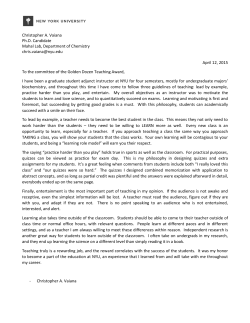
GPH-GU 2930 â 001 Epidemiological Methods and Design
GPH-GU 2930 – 001 Epidemiological Methods and Design Class Schedule: Mondays, 6:45 PM – 8:25 PM Class Location: Silver 518 Semester and Year: : Spring 2015 Professor: Danielle C. Ompad, PhD Phone: 212-992-6142 Email: dco2@nyu.edu Office: 41 East 11th Street, Room 730 Office Hours: by appointment COURSE DESCRIPTION: This 3-unit course will cover in-depth, advanced methods for modern epidemiologic study design, sampling, quantitative measurement, including reliability and validity, and statistical analysis appropriate for selected study designs relevant to global health research and practice. Considerations regarding the responsible conduct of research in international settings will be integrated throughout the course. This doctoral-level lecture/seminar course is offered to graduate students with a basic knowledge of epidemiologic and biostatistical principles, including causal inference, standard study design, confounding, bias, validity, and commonly-used analytical methods. COURSE OBJECTIVES: By the end of the course, students will be able to: 1. Apply the use epidemiological methods to selected global problems. 2. Evaluate epidemiologic studies related to global health priorities in terms of study design, measurement, threats to validity, and data analysis approaches. 3. Examine ethical considerations encountered in the planning and conduct of global research. 4. Explore measurement issues and data analysis considerations within the context of various study designs. PRE-REQUISITES: GPH-GU 2106 or PUHE-GE 2306 1 NYU MPH COMPETENCIES COVERED IN THE COURSE: Objective Competency 1 1. Develop and apply statistical reasoning and methods in addressing, analyzing and solving problems in public health; health care; and biomedical, clinical and populationbased research. 3. Understand the patterns of disease and injury in human populations and apply to the control of health problems. 6. Apply constructs of behavioral, social and cultural theories related to individual and population health and health disparities over the life course. 7. Gather, process, and present information to different audiences in-person, through information technologies, or through media channels. 12. Demonstrate the ability to plan for the design, development, implementation, and evaluation of strategies to improve individual and community health. 2 Develop and apply statistical reasoning and methods in addressing, analyzing and solving problems in public health; health care; and biomedical, clinical and populationbased research. 3. Understand the patterns of disease and injury in human populations and apply to the control of health problems. 7. Gather, process, and present information to different audiences in-person, through information technologies, or through media channels. 12. Demonstrate the ability to plan for the design, development, implementation, and evaluation of strategies to improve individual and community health. 3 11. Demonstrate ethical choices, values and professional practices implicit in public health decisions while considering the effect of choices on community stewardship, equity, social justice and accountability. 4 1. 1. Develop and apply statistical reasoning and methods in addressing, analyzing and solving problems in public health; health care; and biomedical, clinical and populationbased research. 3. Understand the patterns of disease and injury in human populations and apply to the control of health problems. 7. Gather, process, and present information to different audiences in-person, through information technologies, or through media channels. 12. Demonstrate the ability to plan for the design, development, implementation, and evaluation of strategies to improve individual and community health. COURSE REQUIREMENTS AND EXPECTATIONS: Classroom Etiquette It is expected that everyone will: • Attend class and show up on time. • Check their NYU email accounts and NYU Classes regularly for course updates, new materials and announcements. • Complete all readings and be ready to fully participate in the discussions. 2 NYU Classes: NYU Classes (https://home.nyu.edu/academics) will be used extensively throughout the semester for assignments, announcements, and communication. All specific assignment instructions will be available via NYU Classes. Assignments and Grading: Item: Class participation (in-person and on-line) NIH training Lead class discussion in journal club Writing results section exercise • Creating tables from EDA output; determine next analytic steps • Creating tables from modelling output and finalizing multivariable analysis • Writing a results section from data provided Research proposal Pts possible 20 5 100 100 (20) (20) Percent of final grade 5% 5% 10% 30% (6%) (6%) (60) 100 (18%) 50% Class participation (in-person and on-line) Participation includes in-class and on-line contributions. Criteria for evaluation of participation include: evidence that the student read and applied readings to what s/he says in class and writes in the on-line forums; evidence of critical thinking about the topic being discussed; and evidence of any new ideas or perspectives that the student contributes to oral and written discussions. Attendance is obviously necessary for participation. NIH IRB training (due March 23rd, 11:59 PM) In order to learn about research ethics both conceptually and with respect to US federal regulations, you are required to complete the NIH IRB training: https://phrp.nihtraining.com. Upload the completion certificate to this assignment in NYU Classes by March 23, 2015. Lead class discussion in journal club The goal of the journal club is to become familiar with current scientific literature on a variety of topics and to gain experience in gathering, organizing, critically evaluating, presenting and facilitating group discussion of the literature and the implications as it pertains to epidemiology. Specific instructions are available on NYU classes. Writing results section exercise (multiple due dates, see NYU Classes) In the results writing exercise, you will create an analysis plan as a team. Individually, you will develop tables and/or figures from the analysis output and write data collection, data analysis, and results sections of a paper. The exercise is divided into three separate individual assignments: 1. Creating tables and/or figures from exploratory data analysis (EDA) output; determine next analytic steps (20 pts) 2. Creating tables and/or figures from modelling output and finalizing analysis plan (20 pts) 3. Writing a results section from data provided (60 pts) Your papers must not plagiarize. See: www.indiana.edu/~wts/wts/plagiarism.html. These papers will be submitted to Turnitin. See also the NYU GIPH Statement of Academic Integrity. Only doc or docx files are accepted. 3 Research proposal (first draft due May 4, peer review due May 11, final draft due May 18) Your final assignment is to develop a research proposal to investigate an important public health outcome of your choice. The first draft of the proposal is due May 4 at 11:59PM. You will then have one week to review a classmates proposal and provide constructive comments to them by May 11 at 11:59PM. You will then have one week to revise your proposal and submit it to me for grading May 18 at 8:00PM. The research proposal should be 4000-6000 words in length (approximately 6 pages, single spaced; exclusive of references cited and protection of human subjects section). You should have four sections: (1) background and significance, (2) research strategy, (3) protection of human subjects, and (4) references cited. The final document should have ½ inch margins and be single-spaced with Arial 11 pt. font; tables may use Arial 10 pt. font and figures may use Arial 8 pt. font (but sparingly). Citations should use the New England Journal of Medicine citation format (i.e., numeric superscripts). Only doc or docx files are accepted. Your papers must not plagiarize. See: www.indiana.edu/~wts/wts/plagiarism.html. These papers will be submitted to Turnitin. See also the NYU GIPH Statement of Academic Integrity. Specific instructions are available on NYU classes. Grading Scale: A AB+ B B- 93-100 90-92 87-89 83-86 80-82 C+ C CD+ D F 77-79 73-76 70-72 67-69 60-66 <60 Technology Policy: • Mobile device (e.g., smart phones, pagers, etc.) ringers will be turned off or placed on vibrate prior to class. • Laptops and tablets can be used in the classroom to take notes, make calculations, and download/read course materials. Note that research suggests non-academic use of the internet is associated with poorer learning outcomes. 1,2 1 Ravizza SM, Hambrick DZ, Fenn KM. Non-academic internet use in the classroom is negatively related to classroom learning regardless of intellectual ability. Compu Educ. 2014;78:109-114. 2 Gaudreau P, Miranda D, Gareau A. Canadian university students in wireless classrooms: What do they do on their laptops and does it really matter? Compu Educ. 2014;70:245-255. 4 COURSE OUTLINE: Week 1 2 Date 26 Jan 2015 2 Feb 2015 3 4 5 9 Feb 2015 16 Feb 2015 23 Feb 2015 6 2 Mar 2015 7 9 Mar 2015 8 9 16 Mar 2015 23 Mar 2015 10 11 30 Mar 2015 6 Apr 2015 12 13 Apr 2015 Topics NO CLASS – BLIZZARD Course Overview & Writing the research proposal; Establishing relationships: chance, causality, and confounding Sampling: Probability, non-probability NO CLASS – PRESIDENTS’ DAY Measurement: biases, limitations, biological measurement Measurement: scales and indices, psychometrics, surveys Ethical considerations: Global research (on-line discussion, no in-person class) NO CLASS – SPRING BREAK Global disease burden metrics and advanced surveillance methods: Measurement challenges including limitations of surveillance data; innovative metrics for global health tracking Cross-sectional studies Cohort studies: Prospective, retrospective Case-control and case-cohort studies Assignments Due Journal club Journal club Journal club Complete NIH Training Journal club Journal club Journal club Exercise: Creating tables from EDA output and determining next analytic steps Journal club Exercise: Creating tables from modelling output and finalizing multivariable analysis 13 20 Apr 2015 14 27 Apr 2015 15 4 May 2015 16 11 May 2015 Novel and alternative study designs: Stepped wedge, adaptive trials, Bayesian methods, community randomized trials Exploring confounding, mediation and interaction (effect modification) Using existing data: health surveys, vital statistics (clinical data, claims data), social indicators, health registries) Emerging fields: Environmental, genetic, social and spatial epidemiology Journal club Exercise: Writing a results section from data provided Journal club Journal club 5 READING/VIEWING LIST 3 This class requires substantial reading. You may need to read some articles several times, outline the main points, and even look up additional references and background materials. Readings marked “optional” are not required but may be necessary to understand some assigned readings. Week 1 NO CLASS – BLIZZARD Week 2 Course Overview & Writing the research proposal 1. von Elm E, Altman DG, Egger M, Pocock SJ, Gøtzsche PC, Vandenbroucke JP; STROBE Initiative. The Strengthening the Reporting of Observational Studies in Epidemiology (STROBE) statement: guidelines for reporting observational studies. Prev Med. 2007;45(4):247-51. 2. Vandenbroucke JP, von Elm E, Altman DG, Gøtzsche PC, Mulrow CD, Pocock SJ,Poole C, Schlesselman JJ, Egger M; STROBE Initiative. Strengthening the Reporting of Observational Studies in Epidemiology (STROBE): explanation and elaboration. Epidemiology. 2007;18(6):805-35. OPTIONAL (as a resource) 3. Yang OO. Guide to effective grant writing: How to write a successful NIH grant application. New York: Springer, 2012. Chance, causality, and confounding 1. Ahern J, Hubbard A, Galea S. Estimating the effects of potential public health interventions on population disease burden: a step-by-step illustration of causal inference methods. Am J Epidemiol. 2009;169(9):1140-1147. 2. Hernán MA, Hernández-Díaz S, Werler MM, Mitchell AA. Causal knowledge as a prerequisite for confounding evaluation: An application to birth defects epidemiology. Am J Epidemiol. 2002; 155(2):176-84. 3. Rothman KJ, Greenland S, Poole C, Lash TL. Causation and causal inference [Chapter 2]. In Rothman KJ, Greenland S, Lash TL (eds). Modern Epidemiology, 3rd edition. New York: Lippincott, Williams, & Wilkens, 2008. pp. 5-31. OPTIONAL (as a review) 4. Greenland S, Rothman KJ, Lash TL. Measures of effect and measures of association [Chapter 4]. In Rothman KJ, Greenland S, Lash TL (eds). Modern Epidemiology, 3rd edition. New York: Lippincott, Williams, & Wilkens, 2008. pp. 51-70. 5. Glymour MM, Greenland S. Causal diagrams [Chapter 12]. In Rothman KJ, Greenland S, Lash TL (eds). Modern Epidemiology, 3rd edition. New York: Lippincott, Williams, & Wilkens, 2008. pp. 183-209. Week 3 Sampling: Probability, non-probability 1. Heckathorn DD. Snowball versus respondent-driven sampling. Sociol Methodol. 2011;41(1):355-366. 3 Additional readings maybe added. 6 2. Karon JM, Wejnert C. Statistical methods for the analysis of time-location sampling data. J Urban Health. 2012;89(3):565-86. Week 4 NO CLASS – PRESIDENTS’ DAY Week 5 Measurement: biases, limitations, biological measurement 1. Greenland S. Modeling and variable selection in epidemiologic analysis. Am J Public Health. 1989; 79(3):340-9. 2. Delgado-Rodríguez M, Llorca J. Bias. J Epidemiol Community Health. 2004;58(8):635-41. OPTIONAL 3. Sackett DL. Bias in analytic research. J Chronic Dis. 1979;32(1-2):51-63. Week 6 Measurement: scales and indices, psychometrics, surveys 4 1. Measurement, Measuring Instruments, and Psychometric Theory [Chapter 1]. Raykov T, Marcoulides GA. Introduction to Psychometric Theory. New York: Routledge, 2011. pp. 1-12. 2. Reliability [Chapter 6]. Raykov T, Marcoulides GA. Introduction to Psychometric Theory. New York: Routledge, 2011. pp. 137-146. 3. Procedures for estimating reliability [Chapter 7]. Raykov T, Marcoulides GA. Introduction to Psychometric Theory. New York: Routledge, 2011. pp. 147-182. 4. Validity [Chapter 8]. Raykov T, Marcoulides GA. Introduction to Psychometric Theory. New York: Routledge, 2011. pp. 183-221. Week 7 Ethical considerations: Global research 1. Complete NIH IRB training: https://phrp.nihtraining.com/ 2. Ijsselmuiden CB, Kass NE, Sewankambo KN, Lavery JV. Evolving values in ethics and global health research. Glob Public Health. 2010;5(2):154-63. 3. Rid A, Emanuel EJ. Ethical considerations of experimental interventions in the Ebola outbreak. Lancet. 2014;384(9957):1896-9. 4. Folayan M, Brown B, Yakubu A, Peterson K, Haire B. Compassionate use of experimental drugs in the Ebola outbreak. Lancet. 2014;384(9957):1843-4. 5. Adebamowo C, Bah-Sow O, Binka F, Bruzzone R, Caplan A, Delfraissy JF, Heymann D, Horby P, Kaleebu P, Tamfum JJ, Olliaro P, Piot P, Tejan-Cole A, Tomori O, Toure A, Torreele E, Whitehead J. Randomised controlled trials for Ebola: practical and ethical issues. Lancet. 2014;384(9952):1423-4. 6. Shaw D. Randomisation is essential in Ebola drug trials. Lancet. 2014;384(9955):1667. Week 8 NO CLASS – SPRING BREAK 4 You may need to read other chapters in Raykov T, Marcoulides GA. Introduction to Psychometric Theory. New York: Routledge, 2011. 7 Week 9 Global disease burden metrics and advanced surveillance methods 1. Lopez AD, Mathers CD, Ezzati M, Jamison DT, Murray CJL. Measuring the global burden of disease and risk factors, 1990-2001. In Lopez, Alan D., Mathers, Colin D., and Ezzati, Majid, eds. Global Burden of Disease and Risk Factors. Herndon, VA, USA: World Bank Publications, 2006. pp.1-14. 2. Mathers CD, Lopez AD, Murray CJL. The burden of disease and mortality by condition: Data, methods, and results for 2001. In Lopez, Alan D., Mathers, Colin D., and Ezzati, Majid, eds. Global Burden of Disease and Risk Factors. Herndon, VA, USA: World Bank Publications, 2006. pp.45-93. Week 10 Cross-sectional studies 1. Maxwell SE, Cole DA. Bias in cross-sectional analyses of longitudinal mediation. Psychol Methods. 2007;12(1):23-44. Week 11 Cohort studies: Prospective, retrospective 1. Rundle AG, Vineis P, Ahsan H. Design options for molecular epidemiology research within cohort studies. Cancer Epidemiol Biomarkers Prev. 2005; 14(8):1899-907. 2. Cohort studies. Epidemiol Rev 1988; 20(1): 1-136. Week 12 Case-control and case-cohort studies 1. Case-control studies. Epidemiol Rev 1994;16(1):1-164. 2. Greenland S, Thomas DC. On the need for the rare disease assumption in case-control studies. Am J Epidemiol 1982; 116(3):547-53. Week 13 Novel and alternative study designs 1. Hussey MA, Hughes JP. Design and analysis of stepped wedge cluster randomized trials. Contemp Clin Trials. 2007 Feb;28(2):182-91. 2. Murphy AW, Esterman A, Pilotto LS. Cluster randomized controlled trials in primary care: an introduction. Eur J Gen Pract. 2006;12(2):70-3. OPTIONAL 3. Brown CA, Lilford RJ. The stepped wedge trial design: a systematic review. BMC Med Res Methodol. 2006 Nov 8;6:54. 4. Davey Smith G, Ebrahim S, Lewis S, Hansell AL, Palmer LJ, Burton PR. Genetic epidemiology and public health: hope, hype, and future prospects. Lancet 2005; 366:1. 5. Krieger N, Waterman PD, Chen JT, Soobader MJ, Subramanian SV. Monitoring socioeconomic inequalities in sexually transmitted infections, tuberculosis, and violence: geocoding and choice of area-based socioeconomic measures--the public health disparities geocoding project (US). Public Health Rep. 2003;118(3):240-60. 8 Week 14 Exploring confounding, mediation and interaction (effect modification) 1. Morabia A, Ten Have T, Landis JR. Interaction fallacy. J Clin Epidemiol 1997; 50(7):809-12. 2. Zou GY. On the estimation of additive interaction by use of the four-by-two table and beyond. Am J Epidemiol. 2008;168(2):212-24. Week 15 Using existing data TBD Week 16 Emerging fields 1. Social Epidemiology. Epidemiol Rev 2004;26(1):1-135. 2. Berkman LF. Social epidemiology: social determinants of health in the United States: are we losing ground? Annu Rev Public Health. 2009;30:27-41. 3. Beale L, Abellan JJ, Hodgson S, Jarup L. Methodologic issues and approaches to spatial epidemiology. Environ Health Perspect. 2008 Aug;116(8):1105-10. 4. Burton PR, Tobin MD, Hopper JL. Key concepts in genetic epidemiology. Lancet 2005; 366:94151. OPTIONAL 5. Krieger N, Waterman PD, Chen JT, Soobader MJ, Subramanian SV. Monitoring socioeconomic inequalities in sexually transmitted infections, tuberculosis, and violence: geocoding and choice of area-based socioeconomic measures--the public health disparities geocoding project (US). Public Health Rep. 2003;118(3):240-60. Course Policies Please be sure to read the University Policy on Religious Holidays and the policy on safety, weather emergencies, and disruptions. Students with Disabilities: Students with disabilities should contact the Moses Center for Students with Disabilities regarding the resources available to them, and to determine what classroom accommodations should be made available. More information about the Moses Center can be found here. must appear on the syllabus. Information about the center can be found here: https://www.nyu.edu/life/safety-healthwellness/students-with-disabilities.html. Students requesting accommodation must obtain a letter from the Moses Center to provide to me as early in the semester as possible. 9 GIPH Statement of Academic Integrity: The NYU Global Institute of Public Health values both open inquiry and academic integrity. Students in the program are expected to follow standards of excellence set forth by New York University. Such standards include respect, honesty and responsibility. The GIPH does not tolerate violations to academic integrity including: • Plagiarism • Cheating on an exam • Submitting your own work toward requirements in more than one course without prior approval from the instructor • Collaborating with other students for work expected to be completed individually • Giving your work to another student to submit as his/her own • Purchasing or using papers or work online or from a commercial firm and presenting it as your own work Students are expected to familiarize themselves with the GIPH and University’s policy on academic integrity as they will be expected to adhere to such policies at all times – as a student and an alumni of New York University. Plagiarism Plagiarism, whether intended or not, is not tolerated in the GIPH. Plagiarism involves presenting ideas and/or words without acknowledging the source and includes any of the following acts: • Using a phrase, sentence, or passage from another writer's work without using quotation marks • Paraphrasing a passage from another writer's work without attribution • Presenting facts, ideas, or written text gathered or downloaded from the Internet as your own • Submitting another student's work with your name on it • Submitting your own work toward requirements in more than one course without prior approval from the instructor • Purchasing a paper or "research" from a term paper mill. Students in the GIPH and GIPH courses are responsible for understanding what constitutes plagiarism. Students are encouraged to discuss specific questions with faculty instructors and to utilize the many resources available at New York University. Disciplinary Sanctions When a professor suspects cheating, plagiarism, and/or other forms of academic dishonesty, appropriate disciplinary action is as follows: • The Professor will meet with the student to discuss, and present evidence for the particular violation, giving the student opportunity to refute or deny the charge(s). • If the Professor confirms that violation(s), he/she, in consultation with the Program Director may take any of the following actions: o Allow the student to redo the assignment o Lower the grade for the work in question o Assign a grade of F for the work in question o Assign a grade of F for the course o Recommend dismissal Once an action(s) is taken, the Professor will inform the Program Director, and inform the student in writing, instructing the student to schedule an appointment with theAssociate Dean for Academic Affairs, as a final step. The student has the right to appeal the action taken in accordance with the GIPH Student Complaint Procedure. 10
© Copyright 2025










